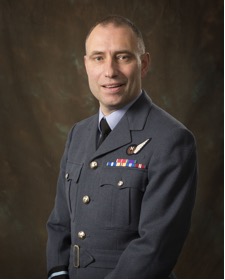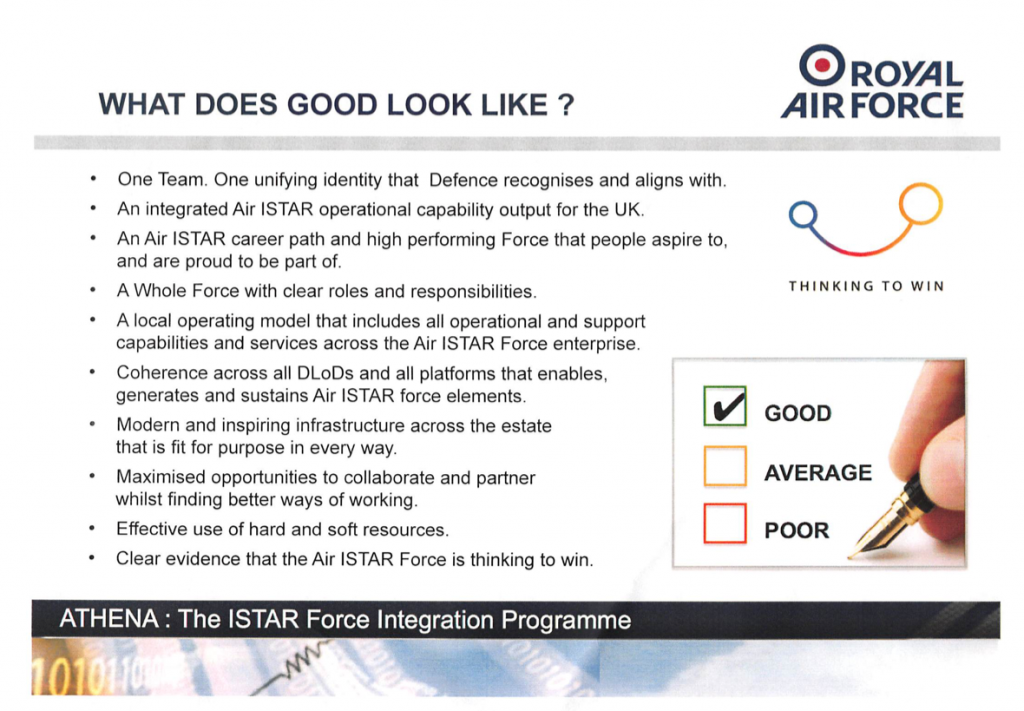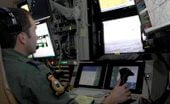2016-07-17 By Robbin Laird
During my visit to the United Kingdom in June 2016, I had a chance to talk with Air Commodore Dean Andrew, the ISTAR Force Commander based at RAF Waddington.
We spoke about the challenges of transforming the current platform focused Air ISTAR community to an integrated Force capability in the future – while continuing to meet today’s warfighting demands.
The challenge is one of balancing current operational commitments, with the introduction of new platforms and capabilities and developing a more integrated enterprise model for 2025.
According to Air Commodore Andrew:
“I have been given a clear mandate for transformation by the RAF senior leadership.
“I need to create the conditions for the integrated Force to emerge and grow to where the Strategic Defence and Security Review tells us to be in 2025.”
The project of transformation is called Programme Athena.
The name is taken from the Greek goddess of reason, intelligent activity, and military victory.
Fierce and brave in battle; she defended the state and home from outside enemies using wisdom, initiative and resources to hand.[ref] Dictionary of Mythology 2015.[/ref]
According to a baseline brief given by the Air Commodore (one of the slides from which is included later in the article), “the key to sustained improvement is working together as a Whole Force, which includes all personnel from serving military personnel and reservists to civil servants, industry partners, and contractors.”
The goal is to shape an “integrated team that can deliver every aspect of operations, support services, facilities and amenities for the UK’s Air ISTAR capability.”
With its hub at RAF Waddington, the Air ISTAR Force comprises five small fleets: E-3D Sentry, Sentinel R1 ASTOR (airborne standoff radar), RC-135 Rivet Joint/Airseeker, MQ-9 Reaper and Shadow R1.
All are supported by the intelligence processing and exploitation expertise of No 1 ISR Wing.
The current force has developed through the serial acquisition of separate platforms.
Personnel and contractor support have been built around these individual platforms and squadrons and there has been a lack of coherent investment in the technical and domestic infrastructure needed to support modern information based warfare or provide sufficient headroom for growth.
There is also the major challenge of manpower and training.
According to Air Commodore Andrew:
“There will need to be an overall uplift of personnel, but if we consider training, career stream manning and common transferrable skills as Force-level opportunities – we can be much more efficient with our collected growth across individual squadrons, units and branches and trades.
“We need to do something radical and innovative to deliver the enhanced capability, but with fewer people than we might have required 10 or 20 years ago when many of our ISTAR capabilities were conceived.
“This is not about doing more with less, but being smarter with our assumptions over how we can operate as an integrated Force and where technology and creative Whole Force concepts can be applied.
All of this has to be in in addition to the military manpower levers of recruitment, retention and talent management to better manage the people we have.”

The Air Commodore recognizes that a fundamental look at how the ISTAR Force does its business is required to deliver the change.
His view of the transformation challenge focuses on the vision and adaptability of his people and the ability to lead, manage and organize at the capability level, not the platform level.
Most important are the qualities those people have.
“I need to have people coming into the force who already have their aperture open and can drive change” stresses the Air Commodore. .
“I need the human equivalent to the 360 degree sensing F-35 airplane as the foundation for the future force.”
He mentions the F35 as an example of the paradigm shift in capability that the RAF will experience as the aircraft comes into service — particularly in terms of its ISR role, which complements its strike capabilities and can be leveraged for the ISTAR Force.
He adds that “the F35 will not be our platform, but it will have core ISTAR contributing capabilities that stretch the boundaries of integration even further for the transformed Force.
The overlapping Venn diagrams that we start to see across the RAF and Defence if we use an ISTAR ‘contributing capability’ lens get bigger and more complex as new and legacy platforms and services become integrated”
The Air Commodore emphasized that the move of ISTAR assets from No. 2 Group to No. 1 Group was a key part of positioning the transformation process.[ref]The role of 2 Group is to provide the operational ‘reach’ and the associated support to UK operations world-wide from its Headquarters at High Wycombe. No 2 Group primarily provides the RAF with Air Transport and Air-to-Air Refuelling (AT/AAR) and Force Protection. Whereas, in addition to ISTAR, 1 Group ,presides over Combat Attack, Battlespace Management and Air Traffic Control , the UK’s Joint Force Air Component HQ and the Joint Air-Land Organization.[/ref]
“We now are directly connected to the users who are demanding our capability.
“This puts us in the position of demand driven change as well.”
Similarly, the introduction into service over the next few years of the Poseidon P-8A offers opportunity to bring the previously stove-piped maritime patrol force into the ISTAR fold.
Air Commodore Andrew sees this as a real test of his transformation leadership – cautioning that “if we don’t view the P8-A as a maritime domain awareness strike asset, rather than a replacement MPA, the UK will never realize the full benefit of their investment and generate the enhanced operational effectiveness that is required for the future Joint Force.
“Making the financial and conceptual space for that enhancement requires a common approach to training, manpower, support and sustainability, information and operating concepts that is at the heart of the transformation.
“Treating each of the platform types as interconnected segments of an ISTAR capability Venn diagram will allow us to create the breadth of intelligence and understanding in the common operating picture that the Joint Force needs.
“Getting out of the platform stovepipe mentality will not be easy; it will be necessary to shape an overall operational approach to where the key operators of the platforms become plug and play elements in the overall ISTAR Force.
“This means changes for civilian and industry partners as well.”
Messaging is important also.
“When you drive onto the base you see as many signs for individual companies as you do welcoming you to ’The Home of the ISTAR Force.’
“This reflects a reality which needs to change.”
He pointed out that a number individual contracts are coming up for renewal, and there will be an opportunity to reshape the working relationship with industry partners in order to come up with more integrated solutions.
The infrastructure on the base is quite old, and one focus for shaping an integrated force could be built around combined requirements and multi-purposing of new infrastructure around new ways of working.

Training offers a good example.
“We need to shape a common training capability, and perhaps in a common building where synthetics will play a key role in shaping the way ahead, in which the key platform operators work together in establishing the joint ISTAR picture.
“By sharing ideas and facilities and technology we can then build in a more integrated cognitive and operational process.”
He sees synthetics and mixed live, virtual and constructive training as the key to the way ahead.
“Both the F35 and P8-A are hugely software driven, which offers tremendous opportunity for connected computer generated training in federated systems – perhaps linked together as spokes to an overall ISTAR synthetic training hub which includes all of the other capabilities in the ISTAR Force.”
We discussed the idea that as the core platforms are replaced by an all software upgradeable fleet, the possibility could exist to put the platforms in competition with one another for modernization upgrades.
“Which upgrade gets the priority for which platform to make the greatest contribution to the integrated ISTAR capability are the sort of decisions that should lie with the ISTAR Force in the future – it is at Force level, not within individual programmes and projects that the overall capability benefit can be seen and prioritized.”
We then discussed the notion of transformation as a process, not an outcome.
The Air Commodore was very keen to stress again the need for “cultural change, where the aperture is opened for the team and they can embrace greater integration”
“We have the iPhone 6 generation in the Force now, yesterday’s analogue approach to our business is no longer appropriate.
“With the aperture fully open, the individual platforms and capabilities become the apps that enable the integrated Force ‘iPhone’.
“Thinking of it in this way, will allow us to tap this new generation of warriors.”
He also seeks to build a sense of strategic purpose and community from bottom to top.
He cited the example of when President Johnson met a janitor at the NASA space center in Houston and when asked what he was doing, the janitor replied: “I am helping put a man on the moon, Mr. President.”
“We are driving to a similar mindset in the ISTAR Force – everyone contributing regardless of where they work.”
He argued that this perspective was essential to mission success.
“The paradigm shift needs to be cultural and organizational if the ISTAR force with a large F to become a reality.
“We are going from a tradition where we have operated isolated force elements to one where an integrated force can deliver 24/7 support and we need to shape a Whole Force solution approach.”
Getting it right for ISTAR is critical to the success of the RAF’s contributions to operations and to the UK’s intelligence and understanding of the world.
The Air Commodore concluded:
“One cannot simply pause, and recapitalize the force in a vacuous power point exercise.
“It is about transformation ‘in contact’ and ensuring that we leverage maximum integrated capability from the new platforms coming to the RAF, while re-brigading the legacy systems as best we can and putting in place the foundations required for an adaptable, upgradeable and technology driven capital F force in the 2025 time frame and beyond.”
Biography for Air Commodore Dean Andrew OBE MA MBA RAF
Air Commodore Andrew was born in Kingston upon Hull. He joined the Service in 1985 and, following training, completed his first tour on IX (Bomber) Squadron at Royal Air Force Brüggen, Germany, operating in both nuclear strike and conventional roles. After a year detachment to Royal Air Force Wittering in 1991 as the Wing Electronic Warfare (EW) Officer, he was re-toured to IX (Bomber) Squadron, becoming one of the first aircrew to operate in the Suppression of Enemy Air Defence (SEAD) role, following the introduction into service of the ALARM missile.
With a background in EW he was selected as an exchange officer to fly the specialist SEAD Tornado with the Luftwaffe. After 11 months at German language school, he moved to Fighter Bomber Wing 32 at German Air Force Lechfeld in November 1996. Following his promotion to squadron leader he was once again posted to Brüggen, this time as a flight commander on 31 ‘Goldstars’ Squadron.
After this tour he was posted to Royal Air Force High Wycombe, where he worked as a staff officer in Headquarters No.1 Group. Following the Advanced Command and Staff Course at the Defence College, Shrivenham in 2002, he was promoted to wing commander and posted to Headquarters Allied Rapid Reaction Corps at Rheindahlen, in Germany, as the Commander’s air advisor.
In January 2006 he took command of 31 Squadron ‘the Goldstars’ at Royal Air Force Marham. He was appointed Officer of the British Empire in 2008 for his successful introduction of ‘lean’ transformation techniques to the Squadron and for leading the air support package to Operation BLENHEIM, the re-deployment of troops from Basra Palace. Having handed over the Goldstars in April 2008, he was promoted to group captain and appointed Commander 903 Expeditionary Air Wing, Basra. On his return in January 2009, he became Chief of Staff of the Joint Air Land Organisation, responsible for tri-Service inter-operability and then spent two years in the Chief of the United States Air Force Strategic Studies Group in the Pentagon. He arrived at Ramstein from the Higher Command and Staff Course at the Joint Service Staff College at Shrivenham.
Air Commodore Andrew took command of the No 1 Group ISTAR Force Headquarters at RAF Waddington at the end of November 2015.
He has more than 2,500 hours on Tornado and has flown combat operations in the Middle East and the Former Republic of Yugoslavia. In 2016 he becomes President of the Rugby Football League – the national governing body of the Sport in the UK.


